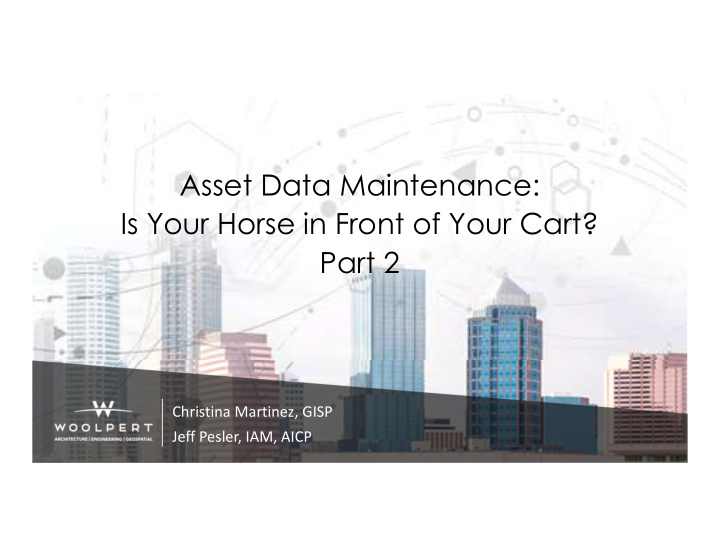



Asset Data Maintenance: Is Your Horse in Front of Your Cart? Part 2 Christina Martinez, GISP Jeff Pesler, IAM, AICP
The Problem Scenario You have funding, requirements, and AMS solution identified... So you're ready to implement, right?
“Cart in Front of Horse” Typical Historical Scenario Implement technology without transitioning to asset management • Install software • Load easily available data • Replace paper and card systems • User resistance to new habits − Extra work − Why change?
“Horse in Front of Cart” Desirable Scenario • Develop organization’s strategic business goals and objectives • Develop understanding of data and decisions needed o Asset life cycle management o Work/maintenance management • Develop business practices to generate and maintain data • Implement technology to support YOUR approach to asset management
What About the Data? • What does the quality/health of the asset registry data have to do with the asset management solution implementation? • When was the last time you reviewed, really reviewed , your asset data?
People, Process and Technology -or- Who, How and What?
Understand the Current State: • People – Organization cross-section: Operations, Engineering, GIS, IT and Finance • Processes/Practices – Asset on-boarding (Engineering Projects; Private Development & Ad-hoc Replacement) – Asset retirement and replacement • Technology – System of record (Asset Registry) – CMMS – Enterprise integrations – Data collection solutions
Five Core Questions 1. What is the current state of my assets? What do I own? Where is it? What condition is it in? What is its performance? What is its remaining useful life? What is its remaining economic value? 2. What is my required level of service (LOS)? What is the demand for my services by my stakeholders? What do regulators require? What is my actual performance ? 3. Which assets are critical to sustained performance? How does it fail? How can it fail? What is the likelihood of failure? What does it cost to repair? What are the consequences of failure? 4. What are my best O&M and CIP repair/replacement strategies? What alternative management options exist? Which are the most feasible for my organization? 5. What is my best long-term investment strategy?
Keep these Six Best Practices in Mind: Apply to Repair / Rehab / 6 Life Cycle Costing Replace Decisions 5 Plan and Execute Planned Maintenance PM/PdM/RCM 4 Asset Condition Rate Critical Assets 3 Set Performance Service Levels Standards 2 Identify Critical Assets Asset Criticality (highest consequence of failure) 1 Asset Inventory Track Asset Inventory Data
Gap Analysis: Basic Asset Registry Information • • Get started with key attributes: Asset Criticality − AssetID − Consequence of Failure (CoF) − Type of asset − Probability of Failure (PoF) − Location − Business Risk Exposure (BRE) − Manufacturer − Material − Size/Capacity − Original Costs − Replacement Cost − Installation/Construction/Renewal Date − Service Life (Initial and Remaining) − Condition − Last Condition Inspection
Keep your Horse in Front of Cart
Continuously Refine: Are the people in place to maintain the data and systems? Is the right information being collected throughout the asset lifecycle? Is the right technology in place to achieve this?
What’s the Pay-Off? • Know Asset Criticality • Line of Site within Organization • Shorter Path to ROI • Prioritize Project Budget/Scope But it’s not all rainbows and unicorns…
THANK YOU christina.martinez@woolpert.com jeff.pesler@woolpert.com
Recommend
More recommend